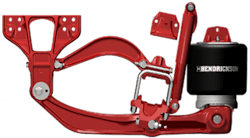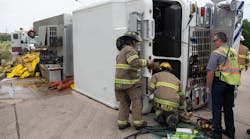When it comes to chassis suspension for fire apparatus, there’s a lot more to it than meets the eyes. In fact, one industry expert says the study of chassis suspension can be shrouded in mystery, like a “black art.”
“People don’t understand it,” said Bob Albano, account manager for fire and rescue apparatus markets for Hendrickson Commercial Vehicle Systems. “There are a lot of things people don’t think about when it comes to suspension,” added Albano, who also has responsibilities in the defense and agricultural markets.
Suspension components on an apparatus are foundational. Everything from the tank to the blinking lights on top ride on some sort of springs, rubber block or air bags.
Firehouse talked to some experts in the field of apparatus suspension to help firefighters and officers navigate the “black art” upon which fire trucks are built.
Most experts agree, when it comes to suspension, that firefighters care about ride and handling and cost of ownership and maintenance. The characteristics of each fire department help determine what kinds of suspension is best for different applications.
There are essentially three kinds of suspension for fire apparatus—leaf spring, rubber block and air rides. There’s also one that’s a variation and that is independent front suspension, kind of like those found on passenger cars and even heavy-duty military vehicles.
Pierce Manufacturing offers all kinds of suspension system and spends a great deal of time with customers picking the right one.
“We offer quite a few different things,” said John Schultz, director of pumper and custom chassis products for Pierce. “There are a lot of different types of apparatus, a lot of different missions in a lot of different regions.”
And, Schultz said, not one suspension system will meet the needs of all departments.
“I am a big advocate of having full conversations with the departments about the truck’s mission,” Schultz said. “You need to hone in, on a high level, what the characteristics of the vehicle will be. You have to know what they want to do with it. Is it an engine? How many occupants will it carry, is it a single axle or a tandem axle? How much water will it carry? These are all good questions to ask.”
Bruce Barton, director of engineering for Ridewell Suspensions, agrees that a conversation between the apparatus builder and the department will lead to good suspension system decisions.
“Ideally, the fire department will have a preference for an apparatus manufacturer who would have the expertise to provide the best solutions,” Barton said. Some departments, particularly large municipal agencies, might have a great deal of suspension history and understand what works best for its applications, he added.
Barton also said that if a particular manufacturer doesn’t offer the kind of suspension specified by a department, it could take exception to the bid specification, offer something else and, in the process end up losing the bid.
“If the vehicle will be a 'custom' heavy-duty chassis, rather than a commercial truck chassis, the manufacturer will likely engineer the requested suspension into their chassis,” Barton said.
And that’s where an education is needed, so departments don’t order equipment that won’t perform the way they expect or need. The National Fire Protection Association (NFPA) has apparatus standards that will keep trucks safe, but there’s a lot of discretion and preferences that can be built into custom apparatus.
Drilling down a bit into the topic, Albano said cost is a key component in the suspension selection process. Other factors are handling, ride comfort, chassis and equipment protection, maintenance and life-cycle costs.
Albano explained that most fire apparatus have a high center of gravity by the very nature of how they are built. To that end, much of the focus on fire apparatus suspension is keeping the top of the rig as stiff and stable as possible.
Albano said air-ride suspension is great for comfort and is often the suspension of choice for over-the-road trucks because truckers spend essentially their careers behind the wheel and comfort is paramount.
Conversely, firefighters typically have a response time of about 10 minutes, or in many cases, less. Comfort is not the primary concern, Albano said, but stability is. So in many cases, air rides on a fire truck are usually not the first choice. Air rides can also be the most expensive systems and have a life span of 12 to 15 years, he said.
The advantages of the air-ride system is a more comfortable ride as well as the ability to load level payload on the apparatus from left to right, Albano said. He added that apparatus don’t always come out balanced side to side, depending on the loads and equipment firefighters place on them. Air-ride suspension will automatically compensate for that imbalance. For that to happen with a leaf-spring system, a shim would have to be placed under the leaf-spring assembly on the offending side, he said, noting that the ride would be harder on one side than another because of the difference in stiffness from side to side.
Air rides, over the long haul, provide a consistent ride quality for the life of the system, Albano said.
On the other end of the spectrum is leaf springs, which have the lowest purchase cost of the systems, but can have a higher maintenance cost with individual leafs having to be replaced as often as two to three years—more frequently in some cases where the roads are particularly rough and the steel spring leafs break because of stress.
Albano said that leaf springs can be the right choice for many apparatus applications. They are stiffer to provide stability for vehicles with a high center of gravity. And for tender/tanker applications, where they might not see as much use as a front-line engine, leaf springs might be the perfect, lower-cost option, he said.
“Springs are going to be the cheapest option and will provide the lowest quality ride,” Albano said, adding that the best ride an apparatus with leaf springs is going to provide is the day it’s delivered. He said springs become harder over time with use, significantly reducing ride quality. And rust jacking, where corrosion between the leaves rubs between each of the stack of leaves that make up the entire spring, is a concern.
An option is the rubber-block suspension, Albano said. Like air rides, the rubber-block suspension is going to provide the best and most consistent ride quality and maintenance cost are minimal too with about the only thing to wear out is a 10-pound block of rubber that is easily changed by one person.
“There is no maintenance on rubber-block suspension, except for the block itself,” Albano said. “There’s no rust and it’s extremely low maintenance. It has a low life-cycle cost. It’s lighter weight than a spring-suspension system.”
Albano said it is “a little more expensive” than the leaf-spring system because it has more components, including transverse torque rods.
Albano said it is important to consider ride quality when specifying a new apparatus. He said high tech equipment can suffer from long-term vibration in the cab and electronics on the body.
“Less vibration is always better,” he said noting that many of the gauges on apparatus are now electronic and might not stand the constant vibration from a poor suspension system. He said in most cases the cost of the suspension on an apparatus account for .2 to .3 percent of the total cost of the apparatus purchased. Therefore, it makes sense for fire departments to consider varieties and make the best choice.
Schultz said that part of the discussion on how to make the best suspension choice should analyze how the vehicle is operated, what is the annual call volume of the department, what are the typical distances for each call and what historic reference points does the department have. For instance, perhaps the vehicle is used for water shuttles and it largely goes to and from a scene. In that case, Schultz said departments might not be too overly concerned about ride quality. He said if the apparatus is going to be sitting at the station more often than not, maybe the leaf-spring system is sufficient.
Maybe the run times are longer and driver and passenger comfort is more important, then Schultz said, customers should look at air ride suspension or even independent suspension, of which Pierce has a proprietary TAK4 system.
“On the front, there’s no question that an independent front-suspension system will provide a better ride quality,” Shultz said. He explained that an independent front-suspension system will provide two to two-and-a-half times wheel travel distance over the spring systems.
Schultz said the driver of apparatus or trucks with leaf springs knows he’s “managing the inputs” as the apparatus hit potholes and “rocks and rolls” down the road.
Conversely, he said drivers who are familiar with independent front suspension notice the vehicles are a little more stable and the driver is in more control.
Schultz also said that while independent suspension is more costly up front, it balances out over the life of the apparatus. He also advised that fire departments need to “compare apples to apples” when it comes to making decisions about suspension. For instance, bigger disc brakes are standard on independent suspension, but are a more expensive option on straight axle front ends.
Barton adds there are pluses and minuses when it comes to independent front suspension. He said they will provide a better quality ride, but little roll stiffness. He added that independent suspension systems typically offer better steer turn angle for a smaller turning radius.
And when it comes to selecting apparatus suspension, it is always best to not “over spring” the rig—meaning don’t specify suspension capable of handling significantly more weight than what will be placed on the unit.
Experts agree that while it might seem logical that it would be better to put in springs that can handle a third or more weight than the unit will carry, it actually has a negative effect on ride.
“The mentality that bigger is always better is not necessarily the case when it comes to apparatus springs,” Schultz said. “To be grossly over spring will result in a poor ride experience, poor performance, undo wear and tear,” he said. “The suspension isn’t traveling or working as well as it should be. Don’t grossly over shoot it or it will be like sitting way back in an empty bus.”
Experts agree, suspension systems are designed to reduce the amount of vibration through the vehicle from road surfaces and to provide stability to apparatus that are big and bulky.
The good news is, there’s a suspension system that is right for your apparatus. And those who specify apparatus need to have an understanding of the pros and cons of each system to pick what will be best for their new rig and their departments.






